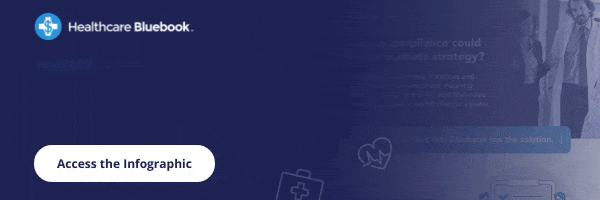-1.jpeg?width=1200&height=800&name=AdobeStock_616686436%20(1)-1.jpeg) Twenty years ago, Healthcare Bluebook introduced the concept of transparency in the healthcare market, founded on the principle that everyone should have access to the true quality and cost of healthcare.
Twenty years ago, Healthcare Bluebook introduced the concept of transparency in the healthcare market, founded on the principle that everyone should have access to the true quality and cost of healthcare.
Long regarded as a transparency pioneer, when the U.S. Congress needed to understand price transparency in healthcare to create the No Surprises Act, Bluebook was the only transparency company asked to testify before the Senate. Right out of the gate, our cost navigation tool fulfilled many of the requirements of the Transparency in Coverage rules and No Surprises Act that began in 2021.
Transparency in Coverage Rules and No Surprises Act
Have you ever received a bill from a provider you don’t recall seeing for a medical procedure? If so, you received a “surprise bill.,” possibly from an out-of-network provider.
Effective January 2022, the No Surprises Act restricted surprise billing for patients. Previously, if an individual received care from an out-of-network provider, the provider could bill them for the difference between the amount the health plan paid and the amount billed, known as a “surprise” or “balance” bill. The No Surprises Act contains several provisions to protect patients from receiving surprise bills.
The Transparency in Coverage rules are aimed at helping patients understand the cost of a covered service before receiving care. The mandates were released in three phases.
- On July 1, 2022, most health plans were required to post pricing information for covered services to help consumers better understand their healthcare costs.
- The next set of requirements went into effect on January 1, 2023, and provided additional access to cost information and enhanced patients’ ability to shop for and choose care that best meets their needs.
- The final phase of the mandates, which goes into effect on January 1, 2024, requires the full release of pricing information for all services.
Bill Kampine, co-founder and chief innovation officer at Healthcare Bluebook, said this about these first two phases: “Bluebook, along with many other organizations, spent a lot of time with legislators, their staffs, and administrators to help them understand to the benefit of self-insured employers, such as what are the financial consequences both for self-insured employers or plan sponsors and their members from lack of transparency in the system? We've gone through phase one. We've got the machine-readable file requirements, naturally we have the consumer tool requirements. The first of what I would call Version 1.0 was successfully launched, in our case, on January 1, 2023.”
Success of the Mandates
Compliance can be an overwhelming process, but solutions like Bluebook Comply™ can turn compliance into a strategic advantage. This solution helps self-insured employers, third-party administrators, and health plans understand, meet, and exceed deadlines for the No Surprises Act and Transparency in Coverage rules.
After two years, Bluebook Comply includes:
- 24,000 hosted machine-readable files
- 586 available unique provider networks, and
- 18,000 total searchable medical procedures.
Bluebook now serves:
- More than 50 third-party administrators and health plan partners
- 25,000 affiliated employer groups, and
- 4 million supported members
For example, one of Bluebook’s public sector sharing trust clients implemented a series of best practices built into Bluebook’s compliance solution resulting in 24.5 percent average monthly utilization and $589,000 in savings in their first year.
“We're getting a lot of really positive feedback in terms of how consumers use those tools,” shared Kampine. “The one thing personally that I find really exciting about this is this notion that the compliance regulations, while well intended for the consumer tools, are great from one standpoint. It is now required that any consumer have access to a transparency tool.”
What’s Missing from the Mandates?
Although the mandates protect consumers from surprise bills and help them understand the cost of procedures before receiving care, several key components must be addressed before healthcare is truly transparent.
According to Kampine, “Pharmacy information, quality information, a focus on the total cost as opposed to your out-of-pocket cost, and ultimately benefit design and incentives that encourage people are missing from the mandates. As we march from Version 1.0 to 2.0—that includes all services—there's a tremendous influx of interest in: ‘OK, we understand that these are the compliance regulations. How do we add in all those other capabilities, that are really the cutting-edge capabilities, that enable us to do the things to affect what we're spending, to affect what our consumers are spending out of their own pockets, and what we as plan sponsors are spending?’”
Ready to Make the Mandates Work to Your Advantage?
Compliance with the Transparency in Coverage rules and the No Surprises Act can be a daunting process. But if we look at compliance from a different perspective, a unique opportunity exists to transform the experience into a business strategy. Download our guide to find out how Bluebook Comply can help your organization use compliance to your advantage.

